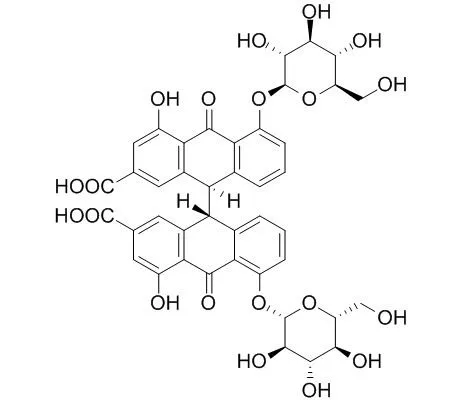| In vitro: |
| Phytomedicine. 2016 Nov 15;23(12):1383-1391. | | Sennoside A, derived from the traditional chinese medicine plant Rheum L., is a new dual HIV-1 inhibitor effective on HIV-1 replication.[Pubmed: 27765358 ] | Despite the availability of effective antiretroviral therapies, drugs for HIV-1 treatment with new mode of action are still needed. An innovative approach is aimed to identify dual HIV-1 inhibitors, small molecules that can inhibit two viral functions at the same time. Rhubarb, originated from Rheum palmatum L. and Rheum officinale Baill., is one of the earliest and most commonly used medicinal plants in Traditional Chinese Medicine (TCM) practice. We wanted to explore TCM for the identification of new chemical scaffolds with dual action abilities against HIV-1.
METHODS AND RESULTS:
R. palmatum L. and R. officinale Baill. extracts along with their main single isolated constituents anthraquinone derivatives were tested on both HIV-1 Reverse Transcriptase (RT)-associated DNA Polymerase (RDDP) and Ribonuclease H (RNase H) activities in biochemical assays. Active compounds were then assayed for their effects on HIV-1 mutated RTs, integrase (IN) and viral replication.
Both R. palmatum L. and R. officinale Baill. extracts inhibited the HIV-1 RT-associated RNase H activity. Among the isolated constituents, Sennoside A and B were effective on both RDDP and RNase H RT-associated functions in biochemical assays. Sennoside A was less potent when tested on K103N, Y181C, Y188L, N474A and Q475A mutated RTs, suggesting the involvement of two RT binding sites for its antiviral activity. Sennoside A affected also HIV-1 IN activity in vitro and HIV-1 replication in cell-based assays. Viral DNA production and time of addition studies showed that Sennoside A targets the HIV-1 reverse transcription process.
CONCLUSIONS:
Sennoside A is a new scaffold for the development of HIV-1 dual RT inhibitors. |
|
| In vivo: |
| Biol Pharm Bull. 2011;34(9):1438-42. | | The influence of glycyrrhiza and antibiotics on the purgative action of sennoside a from Daiokanzoto in mice.[Pubmed: 21881230] | Daiokanzoto (DKT), a Kampo medicine that includes the combination of two crude drugs (rhubarb and glycyrrhiza), is clinically effective for constipation.
The aim of this study is to clarify the influence of glycyrrhiza, three glycyrrhiza constituents (glycyrrhizin, liquiritin, and liquiritin apioside), and eight antibiotics on the purgative action of DKT, rhubarb, or Sennoside A, a constituent of rhubarb, in mice.
METHODS AND RESULTS:
The purgative actions of rhubarb and Sennoside A were significantly intensified when glycyrrhiza was co-administered orally to mice. Liquiritin and liquiritin apioside but not glycyrrhizin showed significant amplification of the purgative action in a dose-dependent manner. The purgative actions of DKT and Sennoside A were significantly reduced by the pre-administration of ampicillin, cefcapene pivoxil, faropenem, fosfomycin, or kanamycin, but were not affected by the pre-administration of clarithromycin or levofloxacin. On the other hand, the purgative action of Sennoside A was significantly reduced by the pre-administration of minocycline, whereas that of DKT was not affected. The effect of minocycline on the purgative action of Sennoside A was lost when glycyrrhiza was co-administered.
CONCLUSIONS:
These results suggest that liquiritin and liquiritin apioside contribute as active substances for the purgative action of DKT, and some antibiotics reduce the purgative action of DKT and Sennoside A. Furthermore, glycyrrhiza has the ability to recover the purgative action of Sennoside A suppressed by minocycline via an unknown mechanism. | | The FASEB Journal, 2015, 29(1): 716.10. | | Protective mechanism on gastric lesion of Sennoside A and Sennoside B[Reference: WebLink] | Sennoside A and sennoside B is evacuant to increase the sensitivity of the colon.
METHODS AND RESULTS:
In vivo test, we performed HCl·ethanol-induced gastritis test, indomethacin-induced gastric ulcer test, gastric secretion in pylorus-ligated test, H+/K+ATPase activity test, gastric emptying and intestinal motility test. In vitro test, we examined acid-neutralizing capacity, quantity of PGE2 and inhibition of H. pylori colonization and we confirmed apoptosis using DAPI nuclear staining, FACS analysis. Sennoside A and B inhibit lesion index in gastritis and gastric ulcer in rats. These results showed that these components reduced gastric juice, an aggressive factor and total acidity and increased pH moderately. In addition, it was made sure that proton pump inhibiton influenced on gastric acid secretion control and that colonization inhibiting activity on H. pylori.
CONCLUSIONS:
As protection enhancing factors to gastric damage, Sennoside A and B increased PGE2 in a concentration-dependent manner. |
|






 Cell. 2018 Jan 11;172(1-2):249-261.e12. doi: 10.1016/j.cell.2017.12.019.IF=36.216(2019)
Cell. 2018 Jan 11;172(1-2):249-261.e12. doi: 10.1016/j.cell.2017.12.019.IF=36.216(2019) Cell Metab. 2020 Mar 3;31(3):534-548.e5. doi: 10.1016/j.cmet.2020.01.002.IF=22.415(2019)
Cell Metab. 2020 Mar 3;31(3):534-548.e5. doi: 10.1016/j.cmet.2020.01.002.IF=22.415(2019) Mol Cell. 2017 Nov 16;68(4):673-685.e6. doi: 10.1016/j.molcel.2017.10.022.IF=14.548(2019)
Mol Cell. 2017 Nov 16;68(4):673-685.e6. doi: 10.1016/j.molcel.2017.10.022.IF=14.548(2019)